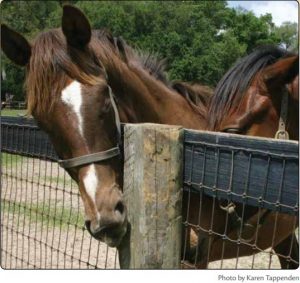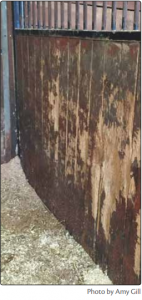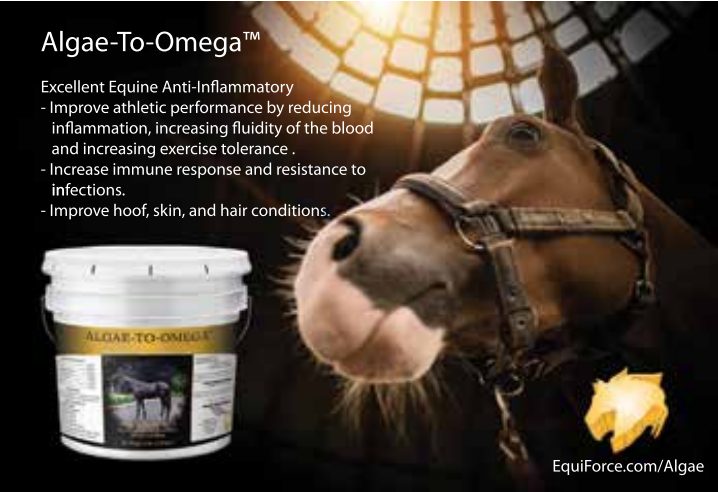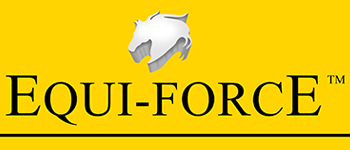The benefits of adding fiber to your horse’s diet
Dr. Amy M. Gill
It’s a constant, never ending battle: A horse wants to chew the wood in its surroundings and as a direct result, the horse owner or barn manager spends countless hours and hard-earned dollars trying to keep the horse from munching away on wood fencing and stalls. And who generally wins? The horse! Even when there is ample amount of long-stemmed forage available, many horses still want to chew on wood.
Many variables may be involved as to why horses crave wood. Stress, boredom, lack of dietary fiber, intestinal tract dysfunction, improper dietary management and unbalanced nutrition are just a few of the variables that may play a role in this behavior. However, some amount of wood consumption is to be considered normal as part of the equine diet. For various reasons, they seek it out and in small amounts, it appears to serve a purpose in helping to maintain good dentition, a correct pH and healthy microbiome in the equine digestive tract and the need to be chewing and salivating for a minimum of 18 hours per day. Therefore, trying to prevent horses from eating wood altogether is a lost cause. Instead, let’s embrace the concept and move forward to add enrichment to equine management and dietary concepts. A reasonable amount of wood consumption in addition to a well- balanced, fibrous diet is natural for the horse.
What is wood?
Wood is an organic, porous and fibrous structural tissue found in the stems and roots of trees and other woody plants. When you look at freshly cut wood under a microscope and you’ll see it’s made up of fiber, like any other plant. The fibers are comprised of three types of structural carbohydrate: cellulose, hemicellulose and lignin. Cellulose and hemicellulose are fermentable fibers and so some of these fractions of wood can be utilized though microbial fermentation into nutrients called volatile fatty acids by the horse as a nutrient source. Lignin is indigestible and therefore unfermentable, but plays a role in providing bulk fiber, which may help prevent acidosis in the hindgut of the horse, by helping to maintain correct pH and hence the health of the microbiome that resides there. Lignin may be the key component of wood that horses crave, because processed and harvested forages normally fed in equine diets contain little to none of this structural carbohydrate.
Why do horses crave wood?
Many stabled horses are affected negatively due to stress from confinement, inability to walk and graze 
of these antiquated management techniques. In contrast, a feral or free ranging horse would have access to graze and browse stems, tree limbs, leaves, bark, lichens, mosses, mushrooms, sticks, dirt, pre- and probiotics and other “woody” components in its daily diet. All of these require a good amount of walking to gather daily as well, which adds to the enrichment of the feral horse’s diet and exercise regime.
A horse stabled or confined to small paddock has no such options and therefore resorts to eating what is available in its immediate surroundings. The time has come to stop restricting normal feeding patterns and think out of the box to simulate natural diets and increased exercise for enrichment as well.
How do we remedy this? By providing enrichment in the stall and paddock and increasing the options on available feedstuffs and yes, even wood purposely made available to chew on.
How can we add wood to a horse’s diet?
Simply put, wood can be mounted in brackets
“Silvopasture is the practice of integrating trees, forage, and the grazing of domesticated animals in a mutually beneficial way. It utilizes the principles of managed grazing, and it is one of several distinct forms of agroforestry,” according to Wikipedia. Planting such a diverse range of edibles such as herbs, plants, shrubs, fungus, trees and grasses provides not only diversity in the diet, but a beautiful pastoral setting, with shade and shelter from the sun, wind and rain. The days of perfectly manicured, high sugar grass seeded and over fertilized pastures for horses need to come to an end. They are not cattle being fattened for market, thankfully.
To check and verify which plants, shrubs and trees are NOT suitable for using as enrichment feedstuffs, please visit: https://en.wikipedia.org/wiki/List_of_plants_poisonous_to_equines
Dr. Amy M. Gill, an equine nutrition consultant, has developed a line of proprietary nutritional supplements called EQUI-FORCE™ which are formulated to promote optimum health and performance in equine athletes. Dr Gill is available for consultation and can be reached at [email protected] or 859-229-2447 or visit www.equiforce.com.



You are so ahead of your time!
Thanks Jill!!!
I found this article very interesting, as I have always wondered if it was okay for them to chew on the wood, and I knew that the old boards that had the lichen on them were for their benefit somehow. Thank you for posting!
You are welcome!